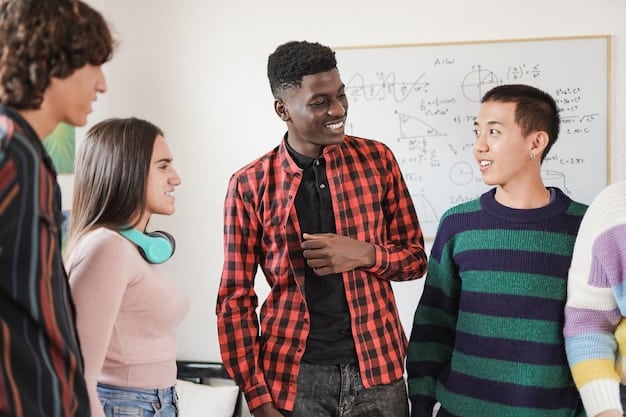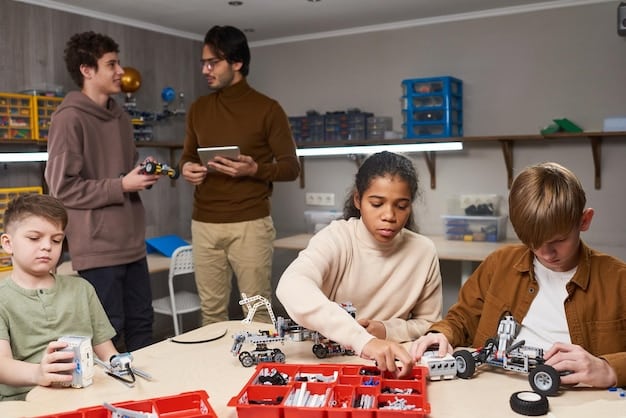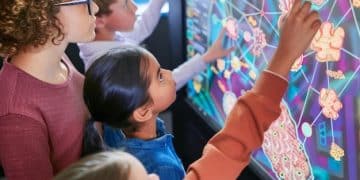Latest Curriculum Development Trends in US High Schools

Anúncios
The latest trends in curriculum development for US high schools are marked by a significant shift towards interdisciplinary learning, personalized education, and the integration of future-ready skills, preparing students for an evolving global landscape and diverse career paths.
Anúncios
In an increasingly dynamic world, the educational landscape must constantly adapt to prepare young minds for future challenges and opportunities. Understanding what are the latest trends in curriculum development for US high schools is crucial for educators, parents, and policymakers alike. This exploration delves into the innovative approaches shaping education, moving beyond traditional models to foster skills vital for success in the 21st century.
Shifting Paradigms: From Rote Learning to Holistic Development
For decades, US high school curricula often emphasized rote memorization and standardized testing, a model increasingly recognized as insufficient for today’s complex world. The shift underway is profound, moving towards an educational philosophy that nurtures critical thinking, creativity, and socio-emotional growth.
This reorientation reflects a growing consensus that while foundational knowledge remains important, the ability to apply that knowledge, adapt to new information, and collaborate effectively is paramount. Modern curriculum development is thus less about what students know, and more about what they can do with what they know. Educators are exploring various pedagogical strategies to achieve this, from project-based learning to inquiry-driven methodologies.
Anúncios
Embracing Interdisciplinary Approaches
One of the most significant shifts is the move away from fragmented, subject-specific learning towards integrated, interdisciplinary models. Instead of learning history, science, and literature in isolation, students connect concepts across subjects, mirroring how knowledge is applied in the real world.
- Enhanced Problem-Solving: Complex problems rarely fit neatly into a single academic discipline. Interdisciplinary studies train students to approach challenges from multiple perspectives.
- Deeper Understanding: Connecting ideas across subjects helps students build a more coherent and robust mental framework of the world.
- Increased Engagement: When learning is contextualized and relevant, students are often more motivated and engaged, seeing the practical implications of their studies.
This approach often involves team-teaching or thematic units that explore a central concept through the lens of different subjects. For instance, a unit on climate change might integrate scientific data analysis, historical context of environmental movements, economic impacts, and literary expressions related to nature.
Personalized Learning: Tailoring Education to Individual Needs
Recognizing that every student learns differently and at their own pace, personalized learning has emerged as a cornerstone of modern curriculum development. This trend leverages technology and flexible instructional strategies to create educational experiences uniquely suited to each student’s strengths, interests, and learning style.
The goal is to move beyond a “one-size-fits-all” model, empowering students to take greater ownership of their learning journey. This requires educators to act more as facilitators and mentors, guiding students through customized learning pathways rather than simply delivering standardized content.
Leveraging Technology for Customization
Technology plays a pivotal role in enabling personalized learning. Learning Management Systems (LMS), adaptive software, and online resources allow for differentiated instruction and pacing.
- Adaptive Learning Platforms: These platforms adjust content difficulty and progression based on a student’s performance, providing targeted instruction.
- Digital Portfolios: Students can curate their work, showcasing their progress and achievements, fostering a sense of accomplishment and self-reflection.
- Online Course Offerings: Expanding access to a wider array of subjects, including advanced placements or vocational courses, allows students to pursue specific interests.
Data analytics also informs personalized learning, providing educators with insights into student performance, allowing them to identify areas where additional support or enrichment is needed. This data-driven approach ensures interventions are timely and effective.
Future-Ready Skills: Preparing for the 21st-Century Workforce
Beyond traditional academic subjects, contemporary curriculum development places a strong emphasis on what are often called “21st-century skills” or “future-ready skills.” These are the competencies deemed essential for success in an increasingly automated, globalized, and interconnected world.
Employers consistently highlight the importance of these skills, often valuing them as much as, if not more than, specific technical knowledge. Curriculum designers are therefore integrating these skills not as standalone units, but as threads woven throughout all subjects.

The Four C’s and Beyond
The “Four C’s” — critical thinking, creativity, collaboration, and communication — remain central to this trend. However, the scope of future-ready skills extends further to include adaptability, digital literacy, and emotional intelligence.
- Critical Thinking: The ability to analyze information, evaluate arguments, and solve problems systematically.
- Creativity: Fostering innovative thinking, encouraging students to generate new ideas and solutions.
- Collaboration: Working effectively with others, valuing diverse perspectives, and contributing to group goals.
- Communication: Expressing ideas clearly and persuasively, both orally and in writing, across various media.
- Digital Literacy: Understanding and navigating the digital world safely, ethically, and effectively, including data analysis and cybersecurity basics.
- Adaptability: The capacity to adjust to new situations, technologies, and challenges with flexibility.
- Emotional Intelligence: Recognizing and managing one’s own emotions, and understanding and influencing the emotions of others.
Integrating these skills means moving beyond lecturing to active learning strategies like simulations, debates, and real-world projects. Assessments also evolve to measure these competencies, often through performance tasks rather than just multiple-choice tests.
Equity and Inclusivity: Designing Curricula for All Learners
A significant trend in curriculum development involves a concerted effort to create more equitable and inclusive learning environments. This means designing curricula that address the diverse needs, backgrounds, and experiences of all students, ensuring every learner has the opportunity to succeed.
This goes beyond mere accessibility; it involves creating culturally responsive pedagogy that validates and affirms students’ identities, and challenges biases inherent in traditional materials. The goal is to close achievement gaps and foster a sense of belonging for every student.
Culturally Responsive Teaching and Representation
Curriculum developers are increasingly focused on incorporating diverse perspectives and experiences into the content. This includes reviewing textbooks and materials for bias, and integrating voices from traditionally marginalized groups.
- Diverse Narratives: Including literature, history, and scientific contributions from a wider range of cultures and backgrounds.
- Multiple Perspectives: Presenting complex topics from various viewpoints to encourage open-mindedness and empathy.
- Inclusive Language: Using language that is respectful and affirming of all identities, including gender, race, ethnicity, and disability.
Furthermore, this trend involves understanding and addressing systemic barriers to learning, such as socio-economic disparities, linguistic differences, and learning disabilities. Universal Design for Learning (UDL) principles are often employed to ensure content is accessible through multiple means of representation, engagement, and expression.
Social-Emotional Learning (SEL): Nurturing Well-Rounded Individuals
Beyond academic achievement, there’s a growing recognition that students need to develop strong social and emotional skills to thrive in school and in life. Social-Emotional Learning (SEL) is the process through which students acquire and apply the knowledge, attitudes, and skills necessary to understand and manage emotions, set and achieve positive goals, feel and show empathy for others, establish and maintain positive relationships, and make responsible decisions.
SEL is no longer seen as an optional add-on but as an integral part of curriculum development. It impacts students’ mental health, academic performance, and overall well-being, fostering a positive school climate and reducing behavioral issues.
Integrating SEL into the Daily Curriculum
SEL is incorporated into curriculum development in various ways, from direct instruction to embedding SEL competencies in academic subjects.
- Self-Awareness: Helping students recognize their emotions, personal strengths, and values.
- Self-Management: Teaching strategies for managing stress, setting goals, and exhibiting self-discipline.
- Social Awareness: Developing empathy for others, understanding social norms, and recognizing diverse perspectives.
- Relationship Skills: Fostering effective communication, conflict resolution, and teamwork.
- Responsible Decision-Making: Guiding students to consider ethical standards, safety concerns, and the well-being of self and others when making choices.
Many schools are adopting specific SEL programs, while others are training teachers to integrate SEL practices into their daily lessons, such as incorporating morning meetings, collaborative projects, and reflective journaling. This holistic approach ensures students are not only academically prepared but also emotionally resilient and socially competent.
Career and Technical Education (CTE): Bridging Academia and Industry
The landscape of career and technical education (CTE) in US high schools is undergoing a significant transformation, moving beyond traditional vocational tracks to offer rigorous, high-quality programs that align with current and future workforce needs. This trend addresses the demand for skilled workers in various industries and provides students with practical, hands-on experience and pathways to post-secondary education or direct employment.
Modern CTE is not about steering students away from college but providing multiple viable pathways. It often involves partnerships with local businesses, community colleges, and industry experts, ensuring the curriculum remains relevant and responsive to economic demands. The integration of academic content with technical skills is key.

Focus on High-Demand Sectors
CTE programs are increasingly concentrating on high-growth, high-wage sectors such as cybersecurity, health sciences, advanced manufacturing, information technology, and renewable energy. This strategic focus ensures that students are trained for jobs that are currently available and projected to grow.
- Industry Certifications: Students can often earn industry-recognized certifications, providing them with a competitive edge in the job market.
- Work-Based Learning: Internships, apprenticeships, and externships offer invaluable real-world experience, allowing students to apply classroom knowledge in professional settings.
- Dual Enrollment: Many CTE programs offer opportunities for dual enrollment, where students can earn college credits while still in high school, saving time and money.
This modernized approach to CTE equips students with both the theoretical knowledge and practical skills necessary for immediate employment or further education in their chosen field. It provides a relevant and engaging education that prepares students for a diverse range of post-secondary options and successful careers.
| Key Trend | Brief Description |
|---|---|
| 📚 Holistic Learning | Moving beyond rote memorization to critical thinking, creativity, and interdisciplinary connections. |
| ✨ Personalized Pathways | Tailoring education to individual student needs using technology and flexible instruction. |
| 🚀 Future-Ready Skills | Emphasis on critical thinking, communication, collaboration, creativity (4 C’s), digital literacy, and adaptability. |
| 🤝 Equity & SEL | Designing inclusive curricula and integrating social-emotional learning for well-being. |
Frequently Asked Questions About High School Curriculum Trends
Personalized learning is crucial because it caters to each student’s unique learning style, pace, and interests. This approach fosters deeper engagement and greater academic success, moving beyond traditional one-size-fits-all methods to create a more effective and equitable educational experience for all learners.
“21st-century skills” like critical thinking, collaboration, and digital literacy are broader competencies that transcend specific subject matter. Unlike traditional academic subjects, which focus on content knowledge, these skills emphasize the practical application of knowledge, problem-solving, and adaptability needed for success in modern careers and global society.
Technology plays a transformative role by enabling personalized learning, access to diverse resources, and interactive experiences. It facilitates adaptive learning platforms, virtual collaborations, and data-driven insights for educators, making learning more dynamic, accessible, and responsive to individual student needs and preferences.
SEL benefits high school students by equipping them with essential skills for managing emotions, building healthy relationships, and making responsible decisions. This leads to improved academic performance, better mental health, reduced behavioral issues, and enhanced overall well-being, preparing them for success beyond the classroom.
No, modern CTE programs are not exclusively for students not pursuing college. They offer rigorous pathways that integrate academic knowledge with hands-on technical skills, preparing students for both direct entry into high-demand careers and seamless transitions to post-secondary education, including two-year and four-year colleges.
Conclusion
The current trends in curriculum development for US high schools reflect a profound and necessary evolution. From fostering holistic development through interdisciplinary learning to embracing personalized pathways and prioritizing future-ready skills, the aim is to create an educational experience that is both relevant and empowering. The integration of equity, inclusivity, social-emotional learning, and robust career and technical education programs underscores a commitment to preparing every student not just for higher education or a job, but for a fulfilling life in a constantly changing world. This dynamic approach ensures that high school graduates are well-equipped to navigate the complexities of the 21st century with confidence and competence.





